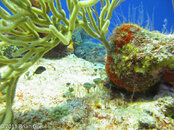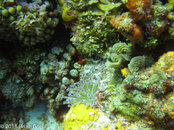nanohawk
Contributor
It's been a couple of years since I have been diving.... (okay 7, but life happens). Aside from buying lots of dive toys I am at a decision point on which camera to take underwater and see if I can avoid flooding it while taking pictures.  I'm buying dive toys because storage and time are not kind to dive gear.
I'm buying dive toys because storage and time are not kind to dive gear. 
I'm currently trying to tease out the advantages and disadvantages of taking a DSLR vs another point and shoot.
I used to dive a Canon Powershot something or other.... probably a G9, but it's been a while so I can't remember. I flooded one in a canon case in Maui one time, and after that I bought an Ikelite case and never had issues. I used a red filter on it and post-process in lightroom for color correction. I did not shoot a flash as at the time strobes were out of my budget.
I currently own a Canon EOS 6D and a nice assortment of lenses. My 17-40 redline would be my pick for diving as it has a minimum focal distance of around a foot. It's my go-to lens for above water shooting as well. I own a 5x Macro, but I don't see that lens being useful underwater. It's got a razor thin focal plane and is challenging enough on a tripod. The 6D is getting a little long in the tooth, but it's a solid camera with good low light performance. It replaced a 7D which had heat issues but was otherwise a great camera. The 7D replaced a 5D Mk II which replaced a 40D, which replaced a Pentax something or other when I finally got serious again about photography and took some classes to dial it in. At one time I had a Pentax K camera and was developing B&W film that I bulk loaded.... so that really dates me, but my point is that I've been doing photography for a long time.
The closest I've ever come to making money as a photographer is doing 3D scanning with a Matterport Camera and doing drone work... technically that is professional photography.. and yea I've made a bundle on both. But that's not dive photography.
For the most part this is a "because I can" / "because I want to" item. I can afford the Ikelite case if I want to, as well as the strobes to go with it.
I don't find underwater seascape photography to be that interesting. I swear if you have seen one parrotfish you've seen them all. Same goes for Nurse sharks, squirrel fish, etc. I do find the little stuff interesting and I like photographing soft corals and the little stuff around them.
If I was to go the P&S route the G7Mk3 seems to be the winner with a 1 inch sensor. I think a used camera and a Ikelite case are the minimum for me. I realize there are other cases, but I'm a big Ikelite fan and I like that the cases can be rebuilt/recertified.
I would really like to dive my big camera, but I have some concerns. My biggest headache is that the Ikelite cases are model specific for the 6D and 6D2.... which makes me consider moving back to a 5D. The 5D Mk3 is cheap these days on the used market so that takes some of the sting out if you give it a saltwater bath. And the case will work for a Mk4, so there is an upgrade path when they release a Mk5. The Mk4 is getting up there in age for Canon, although they released a bunch more alphabet soup recently.
I live in Houston and so the local diving is not photogenic... cold muddy water just doesn't do it for me. I hate cold water. My diving is on weeklong trips and it just is what it is. Living in paradise isn't in the cards for me. I mostly like to be in 30 to 45 foot water. The stuff I like tends to be there and there is decent light.
Enough rambling, here are some questions:
1) For those who made the jump from P&S to DSLR what were your experiences?
2) Folks who went from Four Locks to Dry Lock in Ikelite, was it worth it? Their marketing makes it sound like the only cheese you need....
3) Best travel setup? I'm thinking a hardcase that gets used as a carry on for strobes, dive housing, yada yada. Might be simpler to just check it also... no worse then checking dive gear which is a necessary evil. This is one of the advantages to a point and shoot.
4) Is the pump system for checking cases worth it for those that have it?
I'm currently trying to tease out the advantages and disadvantages of taking a DSLR vs another point and shoot.
I used to dive a Canon Powershot something or other.... probably a G9, but it's been a while so I can't remember. I flooded one in a canon case in Maui one time, and after that I bought an Ikelite case and never had issues. I used a red filter on it and post-process in lightroom for color correction. I did not shoot a flash as at the time strobes were out of my budget.
I currently own a Canon EOS 6D and a nice assortment of lenses. My 17-40 redline would be my pick for diving as it has a minimum focal distance of around a foot. It's my go-to lens for above water shooting as well. I own a 5x Macro, but I don't see that lens being useful underwater. It's got a razor thin focal plane and is challenging enough on a tripod. The 6D is getting a little long in the tooth, but it's a solid camera with good low light performance. It replaced a 7D which had heat issues but was otherwise a great camera. The 7D replaced a 5D Mk II which replaced a 40D, which replaced a Pentax something or other when I finally got serious again about photography and took some classes to dial it in. At one time I had a Pentax K camera and was developing B&W film that I bulk loaded.... so that really dates me, but my point is that I've been doing photography for a long time.
The closest I've ever come to making money as a photographer is doing 3D scanning with a Matterport Camera and doing drone work... technically that is professional photography.. and yea I've made a bundle on both. But that's not dive photography.
For the most part this is a "because I can" / "because I want to" item. I can afford the Ikelite case if I want to, as well as the strobes to go with it.
I don't find underwater seascape photography to be that interesting. I swear if you have seen one parrotfish you've seen them all. Same goes for Nurse sharks, squirrel fish, etc. I do find the little stuff interesting and I like photographing soft corals and the little stuff around them.
If I was to go the P&S route the G7Mk3 seems to be the winner with a 1 inch sensor. I think a used camera and a Ikelite case are the minimum for me. I realize there are other cases, but I'm a big Ikelite fan and I like that the cases can be rebuilt/recertified.
I would really like to dive my big camera, but I have some concerns. My biggest headache is that the Ikelite cases are model specific for the 6D and 6D2.... which makes me consider moving back to a 5D. The 5D Mk3 is cheap these days on the used market so that takes some of the sting out if you give it a saltwater bath. And the case will work for a Mk4, so there is an upgrade path when they release a Mk5. The Mk4 is getting up there in age for Canon, although they released a bunch more alphabet soup recently.
I live in Houston and so the local diving is not photogenic... cold muddy water just doesn't do it for me. I hate cold water. My diving is on weeklong trips and it just is what it is. Living in paradise isn't in the cards for me. I mostly like to be in 30 to 45 foot water. The stuff I like tends to be there and there is decent light.
Enough rambling, here are some questions:
1) For those who made the jump from P&S to DSLR what were your experiences?
2) Folks who went from Four Locks to Dry Lock in Ikelite, was it worth it? Their marketing makes it sound like the only cheese you need....
3) Best travel setup? I'm thinking a hardcase that gets used as a carry on for strobes, dive housing, yada yada. Might be simpler to just check it also... no worse then checking dive gear which is a necessary evil. This is one of the advantages to a point and shoot.
4) Is the pump system for checking cases worth it for those that have it?






